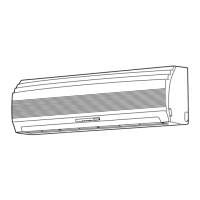
Do you have a question about the Toshiba RAS-13UAV-E2 and is the answer not in the manual?
| Type | Split System |
|---|---|
| Cooling Capacity | 3.5 kW |
| Heating Capacity | 4.0 kW |
| Power Supply | 220-240V, 50Hz |
| Refrigerant | R410A |
Technical specifications including unit model, capacity, power, and dimensions.
Graphs illustrating cooling and heating performance based on compressor speed.
Data showing how cooling and heating capacity changes with outdoor temperature.
Crucial safety precautions and procedures for handling R410A refrigerant.
Guidelines for selecting and processing piping materials and joints for R410A.
Detailed diagrams and dimensions for the indoor unit assembly.
Detailed diagrams and dimensions for the outdoor unit assembly.
Schematic illustrating the electrical connections within the indoor unit.
Schematic illustrating the electrical connections within the outdoor unit.
List and specifications of electrical components used in the indoor unit.
List and specifications of electrical components used in the outdoor unit.
Schematic showing the path and components of the refrigerant flow.
Block diagram illustrating the control functions of the indoor unit.
Block diagram illustrating the control functions of the outdoor unit.
General overview of how the air conditioner system is controlled.
Detailed explanation of various operational circuits and modes.
Procedures for setting and using temporary auto and cooling operations.
Details on the auto restart feature, including setup and cancellation.
Explanation of remote control buttons, display indications, and features.
Essential safety guidelines and precautions for installing the unit.
Step-by-step instructions for installing the indoor unit.
Step-by-step instructions for installing the outdoor unit.
Initial checks for power supply and primary troubleshooting methods.
Interpreting flashing LEDs on the indoor unit for fault codes.
Using the remote control for self-diagnosis and interpreting check codes.
Diagnosing problems based on specific symptoms and circuit failures.
Procedures for diagnosing and troubleshooting issues with the outdoor unit.
Methods for checking the resistance and condition of key components.
Step-by-step procedures for removing and replacing indoor unit components.
Procedures for accessing and replacing the microcomputer (P.C. board).
Step-by-step procedures for removing and replacing outdoor unit components.
Exploded view and part list for the indoor unit E-Parts assembly.
Detailed exploded view and part number list for the indoor unit.
Detailed exploded view and part number list for the outdoor unit.
Exploded view and part list for the outdoor unit E-Parts assembly.











